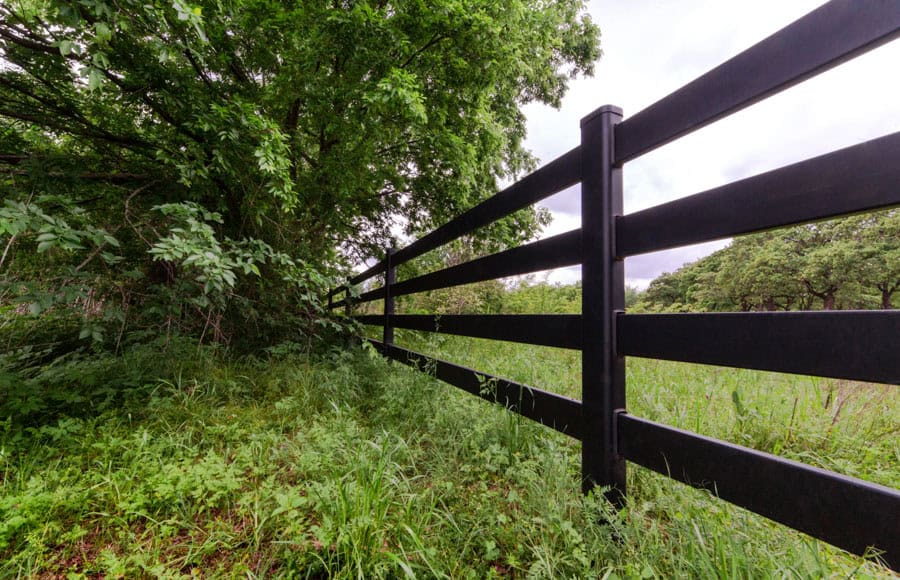There’s a moment every rancher faces—standing at the edge of your property, looking out across your land, knowing the type of fence you choose isn’t just about marking boundaries. It’s about protecting your horses, securing your investment, and (let’s be honest) setting the tone for your entire operation.
Whether you’re replacing old fencing or starting fresh, the choice between vinyl, wood, and steel isn’t one to take lightly.
We’ve seen it all in our years of working with ranchers and horse owners across the country. Each fencing material has its place, and each comes with its own set of truths—some that might surprise you. From the traditional appeal of wood to the modern convenience of vinyl and the unmatched durability of steel, your choice will impact your daily operations and your bottom line for years to come.
Let’s cut through the noise and talk about what really matters when it comes to these three fencing options. No fancy sales pitch. Just straight talk about what works, what doesn’t, and why it matters for your property.
Real-World Considerations for Finding the Right Fence
When you’re investing in fencing that needs to last, it’s not just about what looks good on paper. Your fence is going to face real challenges every single day. We’ve worked with enough ranchers to know that a beautiful fence means nothing if it can’t handle your stallion testing its strength or stand up to those brutal summer storms.
First, let’s talk horses. Any experienced owner knows they can be hard on fencing—whether they’re scratching, leaning, or sometimes deciding to test just how sturdy that post really is. Your fence needs to be strong enough to keep them safely contained without risking injury if they do make contact. That elegant design you’re eyeing? It needs to back up its looks with genuine durability.
Then there’s your day-to-day operation. Think about those early mornings moving equipment through gates, the wear and tear from routine maintenance, and yes, even those unexpected incidents with machinery. Your fence needs to handle it all while keeping its integrity intact. What looks pristine on installation day needs to keep performing years down the road.
Weather’s another factor that separates a good fence from a great one. Whether you’re dealing with heavy snow loads, intense summer heat, or driving rain, your fencing choice needs to stand up to whatever Mother Nature throws at it. We’ve seen plenty of “bargain” options fail after just a few seasons of harsh weather.
Finally, there’s the investment angle. Smart ranchers know that the initial price tag isn’t the whole story. It’s about how much time and money you’ll spend maintaining it over the years, and how long it’ll last before needing replacement. Sometimes paying more upfront means spending a lot less down the road.
Vinyl vs. Wood vs. Steel Fences: Summary
Wood brings that classic ranch feel but demands regular attention. Vinyl offers a clean look with less upkeep, though it has its limitations. Steel…well, it’s like that reliable ranch hand that shows up every day, year after year, ready for whatever comes its way. Let’s break down exactly what you can expect from each:
| Feature | Wood Fence | Vinyl Fence | Steel Fence |
| Initial Cost | Moderate | Higher | Premium |
| Life Expectancy | 10-15 years with maintenance | 20-30 years | 40+ years |
| Maintenance Required | High – Regular staining/sealing, repair of warped/rotted boards, checking for loose nails/screws | Low – Occasional washing, minor repairs for severe impacts | Minimal – Occasional washing, potential touch-up of scratches |
| Weather Resistance | Poor to Moderate – Susceptible to rot, warping, and sun damage | Good – Resistant to moisture, won’t rot, can become brittle in extreme cold | Excellent – Handles all weather conditions, won’t rot or warp |
| Impact Resistance | Moderate – Can splinter or break under heavy impact | Fair – Can crack or shatter in cold weather or heavy impact | Excellent – Highest impact resistance of all three |
| Horse Safety | Good – Natural material but can splinter; nails/screws can work loose | Very Good – Smooth surface, no splinters, but can shatter | Excellent – Strong, smooth, won’t splinter or shatter |
| Aesthetic Longevity | Fair – Weathers and fades over time | Good – Color stable but can yellow slightly | Excellent – Maintains appearance with minimal care |
| Property Value Impact | Moderate Positive – Traditional appeal | Moderate Positive – Clean look | High Positive – Premium appearance and durability |
| Environmental Factors | Moderate – Natural material but requires regular replacement | Poor – Not biodegradable, petroleum-based | Good – Long lifespan, recyclable |
Each option has its place, depending on your specific needs and circumstances. While wood might work fine for a small paddock that gets light use, you might want to think twice before using it for your main pasture fencing. Vinyl can be a solid choice for areas where appearance is important, but steel often proves to be the wisest long-term investment for serious ranching operations.
Wood Fencing: The Traditional Choice
There’s something about a wood fence that just belongs on a ranch. That rich, natural look ages like a fine leather saddle when it’s done right. Drive past any historic ranch, and chances are you’ll see wood fencing standing as a testament to the generations before us. But let’s talk about what that classic look really means for your operation today.
Wood fencing brings natural beauty that’s hard to match. On the practical side, it’s relatively easy to install and repair, and most ranch hands can handle basic maintenance with tools they already have on hand. When damage does occur, you can usually replace individual boards or posts without taking down entire sections. Plus, the initial cost is often easier on the wallet than other options.
However, wood requires consistent attention if you want it to last. We’re talking about regular inspections for rot, especially where posts meet the ground. You’ll need to stay on top of staining or sealing every few years, and that’s not counting the time spent checking for loose boards or protruding nails that could harm your horses. In harsh weather—whether it’s the beating sun or heavy rains—wood will eventually warp, split, or rot.
It’s not a matter of if, but when.
If you’re drawn to wood fencing, understand what you’re signing up for. Factor in not just the initial cost, but the time and money you’ll spend on maintenance. For some areas of your property (maybe around the house or in less-demanding spots), wood can still be a solid choice. But for your main horse enclosures or high-traffic areas? You might want to think twice.
Vinyl Fencing: The Modern Alternative
At first glance, vinyl fencing seems like the perfect solution: clean lines, low maintenance, and a crisp look that stays fresh year after year. It’s why we’ve seen more ranchers considering it, especially for their front paddocks or areas where appearances matter most.
The appeal is obvious: no painting, no staining, and a quick wash with soap and water keeps it looking new. When you’re running a busy operation, that kind of simplicity is mighty tempting. Plus, there’s no splintering to worry about, and horses tend to respect the solid visual barrier it provides. For many property owners, especially those with show facilities or boarding operations, vinyl’s professional appearance helps justify premium rates.
Yet, vinyl has its limits. In extreme cold, it can become brittle and crack under impact. Those pristine white panels? They can yellow over time in intense sun, and while manufacturers have improved their materials, it’s still something to consider. And when vinyl does get damaged, you’re usually looking at replacing entire sections rather than just a board or two.
The upfront investment is higher than wood, no way around it. But the math starts making more sense when you factor in the reduced maintenance costs over the years. No staining, no painting, and generally fewer repairs needed. That said, when repairs are necessary, they tend to hit the wallet harder than wood fixes.
Vinyl has earned its place in modern ranching, but location is key. It’s at its best in controlled environments (think paddocks near the barn, training areas, or property boundaries where appearance matters). But for those rough-and-tumble areas where your horses really test the fencing? You might want something with more grit. And if you’re in an area with extreme temperature swings or heavy equipment moving around, keep those factors in mind.
Steel Fencing: The Reliable Investment
When it comes to steel, you get what you pay for (and then some). Like a well-built truck that keeps running long after the fancy cars have broken down, steel fencing stands as the workhorse of the industry. It’s not just about strength; it’s about peace of mind.
We’ve seen steel horse fences take hits that would’ve shattered vinyl or splintered wood, and bounce right back. Whether it’s your 1,200-pound stallion testing the boundaries or that unexpected run-in with the tractor, steel holds its ground. This isn’t just talk—we’ve watched these fences stand strong through decades of harsh winters, blistering summers, and everything Mother Nature throws at them. When we say lifetime investment, we mean it.
Not all steel fencing is created equal, and this is where straight talk matters. Quality steel fencing, like what we offer at Buckley, comes with proper coating systems that prevent rust and maintain appearance. The initial investment might raise eyebrows, but here’s the truth: while you’re replacing wood fences or repairing vinyl for the second or third time, that steel fence will still be standing strong, looking just as good as the day it was installed.
A premium steel fence can last 40+ years with minimal maintenance. No painting, replacing rotted posts, or fixing broken boards. Just occasional washing to keep it looking sharp. For busy ranch operations, that kind of reliability isn’t just convenient—it’s downright essential. Your fence line is your property’s handshake, and steel gives the firmest grip.
Yes, steel fencing costs more upfront. But spread that cost over its lifetime, factor in the minimal maintenance, and consider the safety it provides for your valuable horses…suddenly it becomes clear why more ranchers are making the switch.
Invest in a Fence You Can Trust with Buckley
When you’ve spent years building your ranch or equestrian operation, the last thing you need is to worry about your fence line. While wood brings classic charm and vinyl offers modern convenience, our experience shows that steel fencing stands head and shoulders above the rest for serious ranchers who demand the best.
At Buckley Fence, we’ve spent generations understanding what works and what doesn’t in the real world of ranching. We’ve seen the challenges you face firsthand, from protecting valuable horses to maintaining your property’s value. That’s why we stake our reputation on premium steel fencing that lives up to the promises we make.
Your fence line isn’t just about marking boundaries. It’s about securing your investment, protecting your horses, and maintaining the professional image your operation deserves. When you’re ready to make that investment, we’re here to help you do it right the first time.
Take the next step toward securing your property with horse fencing that’s built to last. Give us a call or send us a message to learn more about our premium steel fencing options. We’ll help you make the choice that makes sense for your operation, your horses, and your future.



